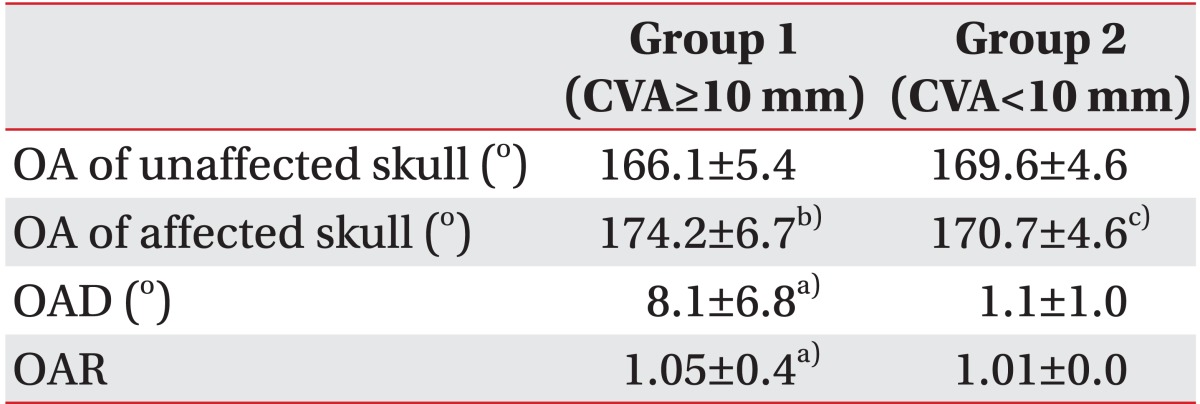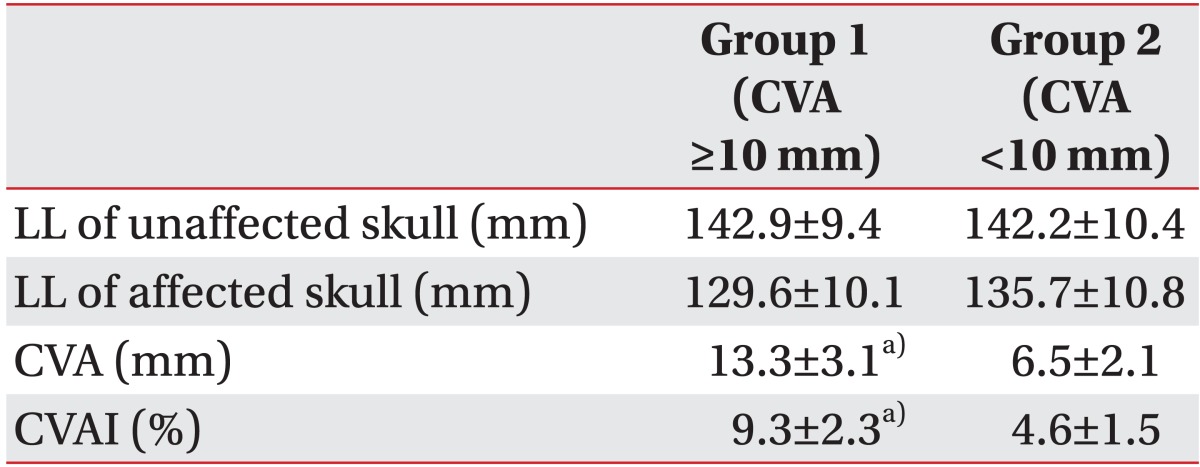1. Argenta L, David L, Thompson J. Clinical classification of positional plagiocephaly. J Craniofac Surg. 2004; 15:368–372. PMID:
15111792.

2. Spermon J, Spermon-Marijnen R, Scholten-Peeters W. Clinical classification of deformational plagiocephaly according to Argenta: a reliability study. J Craniofac Surg. 2008; 19:664–668. PMID:
18520381.
3. Peitsch WK, Keefer CH, LaBrie RA, Mulliken JB. Incidence of cranial asymmetry in healthy newborns. Pediatrics. 2002; 110:e72. PMID:
12456939.

4. van Vlimmeren LA, Takken T, van Adrichem LN, van der Graaf Y, Helders PJ, Engelbert RH. Plagiocephalometry: a non-invasive method to quantify asymmetry of the skull; a reliability study. Eur J Pediatr. 2006; 165:149–157. PMID:
16211401.

5. Mulliken JB, Vander Woude DL, Hansen M, LaBrie RA, Scott RM. Analysis of posterior plagiocephaly: deformational versus synostotic. Plast Reconstr Surg. 1999; 103:371–380. PMID:
9950521.

6. Dias MS, Klein DM. Occipital plagiocephaly: deformation or lambdoid synostosis? II. A unifying theory regarding pathogenesis. Pediatr Neurosurg. 1996; 24:69–73. PMID:
8841076.
7. Littlefield TR, Kelly KM, Pomatto JK, Beals SP. Multiple-birth infants at higher risk for development of deformational plagiocephaly. Pediatrics. 1999; 103:565–569. PMID:
10049957.
8. Argenta LC, David LR, Wilson JA, Bell WO. An increase in infant cranial deformity with supine sleeping position. J Craniofac Surg. 1996; 7:5–11. PMID:
9086895.

9. Boere-Boonekamp MM, van der Linden-Kuiper LT. Positional preference: prevalence in infants and follow-up after two years. Pediatrics. 2001; 107:339–343. PMID:
11158467.

10. de Chalain TM, Park S. Torticollis associated with positional plagiocephaly: a growing epidemic. J Craniofac Surg. 2005; 16:411–418. PMID:
15915106.

11. Bruneteau RJ, Mulliken JB. Frontal plagiocephaly: synostotic, compensational, or deformational. Plast Reconstr Surg. 1992; 89:21–33. PMID:
1727260.

12. Biggs WS. Diagnosis and management of positional head deformity. Am Fam Physician. 2003; 67:1953–1956. PMID:
12751657.
13. David DJ, Menard RM. Occipital plagiocephaly. Br J Plast Surg. 2000; 53:367–377. PMID:
10876272.

14. Hummel P, Fortado D. Impacting infant head shapes. Adv Neonatal Care. 2005; 5:329–340. PMID:
16338671.

15. Mortenson PA, Steinbok P. Quantifying positional plagiocephaly: reliability and validity of anthropometric measurements. J Craniofac Surg. 2006; 17:413–419. PMID:
16770174.
16. Sze RW, Parisi MT, Sidhu M, Paladin AM, Ngo AV, Seidel KD, et al. Ultrasound screening of the lambdoid suture in the child with posterior plagiocephaly. Pediatr Radiol. 2003; 33:630–636. PMID:
12879318.

17. Akel I, Yazici M. Growth modulation in the management of growing spine deformities. J Child Orthop. 2009; 3:1–9. PMID:
19308606.

18. Davis MT, Loyd AM, Shen HY, Mulroy MH, Nightingale RW, Myers BS, et al. The mechanical and morphological properties of 6 year-old cranial bone. J Biomech. 2012; 45:2493–2498. PMID:
22939291.

19. Regelsberger J, Milovanovic P, Schmidt T, Hahn M, Zimmermann EA, Tsokos M, et al. Changes to the cell, tissue and architecture levels in cranial suture synostosis reveal a problem of timing in bone development. Eur Cell Mater. 2012; 24:441–458. PMID:
23188743.

20. Duterloo HS, Enlow DH. A comparative study of cranial growth in Homo and Macaca. Am J Anat. 1970; 127:357–368. PMID:
4985059.
21. Mathijssen IM, van Splunder J, Vermeij-Keers C, Pieterman H, de Jong TH, Mooney MP, et al. Tracing craniosynostosis to its developmental stage through bone center displacement. J Craniofac Genet Dev Biol. 1999; 19:57–63. PMID:
10416148.

22. Moenning A, Jager R, Egert A, Kress W, Wardelmann E, Schorle H. Sustained platelet-derived growth factor receptor alpha signaling in osteoblasts results in craniosynostosis by overactivating the phospholipase C-gamma pathway. Mol Cell Biol. 2009; 29:881–891. PMID:
19047372.
23. Maloul A, Fialkov J, Whyne CM. Characterization of the bending strength of craniofacial sutures. J Biomech. 2013; 46:912–917. PMID:
23352773.

24. Jaslow CR. Mechanical properties of cranial sutures. J Biomech. 1990; 23:313–321. PMID:
2335529.

25. Herring SW. Mechanical influences on suture development and patency. Front Oral Biol. 2008; 12:41–56. PMID:
18391494.

26. Regelsberger J, Delling G, Tsokos M, Helmke K, Kammler G, Kranzlein H, et al. High-frequency ultrasound confirmation of positional plagiocephaly. J Neurosurg. 2006; 105(5 Suppl):413–417. PMID:
17328267.

27. Anderson PJ, Netherway DJ, David DJ, Self P. Scanning electron microscope and micro-CT evaluation of cranial sutures in health and disease. J Craniofac Surg. 2006; 17:909–919. PMID:
17003620.

28. Reinholt LE, Burrows AM, Eiting TP, Dumont ER, Smith TD. Brief communication: histology and micro CT as methods for assessment of facial suture patency. Am J Phys Anthropol. 2009; 138:499–506. PMID:
19170212.

29. Benz MG, Benz MW. Reduction of cancer risk associated with pediatric computed tomography by the development of new technologies. Pediatrics. 2004; 114:205–209. PMID:
15231929.

30. Brenner D, Elliston C, Hall E, Berdon W. Estimated risks of radiation-induced fatal cancer from pediatric CT. AJR Am J Roentgenol. 2001; 176:289–296. PMID:
11159059.

31. Hall EJ. Lessons we have learned from our children: cancer risks from diagnostic radiology. Pediatr Radiol. 2002; 32:700–706. PMID:
12244457.

32. Robinson S, Proctor M. Diagnosis and management of deformational plagiocephaly. J Neurosurg Pediatr. 2009; 3:284–295. PMID:
19338406.

33. Rogers GF. Deformational plagiocephaly, brachycephaly, and scaphocephaly. Part II: Prevention and treatment. J Craniofac Surg. 2011; 22:17–23. PMID:
21187782.
34. Yoo HS, Rah DK, Kim YO. Outcome analysis of cranial molding therapy in nonsynostotic plagiocephaly. Arch Plast Surg. 2012; 39:338–344. PMID:
22872837.

35. McGarry A, Dixon MT, Greig RJ, Hamilton DR, Sexton S, Smart H. Head shape measurement standards and cranial orthoses in the treatment of infants with deformational plagiocephaly. Dev Med Child Neurol. 2008; 50:568–576. PMID:
18754893.

36. Wilbrand JF, Wilbrand M, Pons-Kuehnemann J, Blecher JC, Christophis P, Howaldt HP, et al. Value and reliability of anthropometric measurements of cranial deformity in early childhood. J Craniomaxillofac Surg. 2011; 39:24–29. PMID:
20418107.






 PDF
PDF ePub
ePub Citation
Citation Print
Print




 XML Download
XML Download